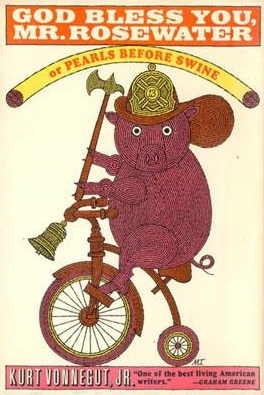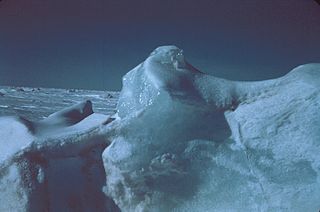Related Research Articles

Kurt Vonnegut was an American writer and humorist known for his satirical and darkly humorous novels. In a career spanning over 50 years, he published fourteen novels, three short-story collections, five plays, and five nonfiction works; further collections have been published after his death.

Cat's Cradle is a satirical postmodern novel, with science fiction elements, by American writer Kurt Vonnegut. Vonnegut's fourth novel, it was first published in 1963, exploring and satirizing issues of science, technology, the purpose of religion, and the arms race, often through the use of morbid humor.

Cohoes is an incorporated city located in the northeast corner of Albany County in the U.S. state of New York. It is called the "Spindle City" because of the importance of textile manufacturing to its growth in the 19th century. The city's factories processed cotton from the Deep South.

Troy is a city in the United States state of New York and is the county seat of Rensselaer County. It is located on the western edge of that county on the eastern bank of the Hudson River just northeast of the capital city of Albany. Troy has close ties to Albany and nearby Schenectady, forming a region popularly called the Capital District although it more accurately is referred to as the Capital Region since there is no "district" per se.

Slaughterhouse-Five, or, The Children's Crusade: A Duty-Dance with Death is a 1969 semi-autobiographic science fiction-infused anti-war novel by Kurt Vonnegut. It follows the life and experiences of Billy Pilgrim, from his early years, to his time as an American soldier and chaplain's assistant during World War II, to the post-war years, with Billy occasionally traveling through time. The text centers on Billy's capture by the German Army and his survival of the Allied firebombing of Dresden as a prisoner of war, an experience which Vonnegut himself lived through as an American serviceman. The work has been called an example of "unmatched moral clarity" and "one of the most enduring anti-war novels of all time".
Between Time and Timbuktu is a television film directed by Fred Barzyk and based on a number of works by Kurt Vonnegut. Produced by National Educational Television and WGBH-TV in Boston, Massachusetts, it was telecast March 13, 1972 as a NET Playhouse special. The television script was also published in book form in 1972, illustrated with photographs by Jill Krementz and stills from the production.

Breakfast of Champions, or Goodbye Blue Monday is a 1973 novel by the American author Kurt Vonnegut. His seventh novel, it is set predominantly in the fictional town of Midland City, Ohio, and focuses on two characters: Dwayne Hoover, a Midland resident, Pontiac dealer and affluent figure in the city, and Kilgore Trout, a widely published but mostly unknown science fiction author. Breakfast of Champions deals with themes of free will, suicide, and race relations, among others. The novel is full of drawings by the author, substituting descriptive language with depictions requiring no translation.

Player Piano is the first novel by American writer Kurt Vonnegut Jr., published in 1952. The novel depicts a dystopia of automation partly inspired by the author's time working at General Electric, describing the negative impact technology can have on quality of life. The story takes place in a near-future society that is almost totally mechanized, eliminating the need for human laborers. The widespread mechanization creates conflict between the wealthy upper class, the engineers and managers, who keep society running, and the lower class, whose skills and purpose in society have been replaced by machines. The book uses irony and sentimentality, which were to become hallmarks developed further in Vonnegut's later works.

God Bless You, Mr. Rosewater, or Pearls Before Swine, Kurt Vonnegut's fifth novel, was published in 1965 by Holt, Rinehart and Winston and as a Dell mass-market paperback in 1970. A piece of postmodern satire, it gave context to Vonnegut's following novel, Slaughterhouse-Five and shared in its success.
A granfalloon, in the fictional religion of Bokononism, is defined as a "false karass". That is, it is a group of people who affect a shared identity or purpose, but whose mutual association is meaningless.
Kilgore Trout is a fictional character created by author Kurt Vonnegut. Trout is a notably unsuccessful author of paperback science fiction novels.

Galápagos (1985) is the eleventh novel published by American author Kurt Vonnegut. Set in the Galápagos Islands after a global financial disaster, the novel questions the merit of the human brain from an evolutionary perspective. The title is both a reference to the islands on which part of the story plays out, and a tribute to Charles Darwin, on whose theory Vonnegut relies to reach his own conclusions. It was published by Delacorte Press.
Ilium or Ileum may refer to:
Bernard Vonnegut was an American atmospheric scientist credited with discovering that silver iodide could be used effectively in cloud seeding to produce snow and rain. He was the older brother of American novelist Kurt Vonnegut.

Ice-nine is a fictional material that appears in Kurt Vonnegut's 1963 novel Cat's Cradle. Ice-nine is described as a polymorph of water which instead of melting at 0 °C (32 °F), melts at 45.8 °C (114.4 °F). When ice-nine comes into contact with liquid water below 45.8 °C, it acts as a seed crystal and causes the solidification of the entire body of water, which quickly crystallizes as more ice-nine. As people are mostly water, ice-nine kills nearly instantly when ingested or brought into contact with soft tissues exposed to the bloodstream, such as the eyes or tongue. It wasn't explained why the same doesn't happen by mere skin contact or inhalation of dust generated from mechanical impacts.

Slaughterhouse-Five is a 1972 American comedy-drama military science fiction film directed by George Roy Hill and produced by Paul Monash, from a screenplay by Stephen Geller, based on the 1969 novel of the same name by Kurt Vonnegut. The film stars Michael Sacks as Billy Pilgrim, who is "unstuck in time" and has no control over where he is going next. It also stars Ron Leibman as Paul Lazzaro and Valerie Perrine as Montana Wildhack.
Palm Sunday is a 1981 collection of short stories, speeches, essays, letters, and other previously unpublished works by Kurt Vonnegut.
"Yon Yonson" is an infinitely recursive song, perhaps best known from the novel Slaughterhouse-Five by Kurt Vonnegut, although Vonnegut did not create it.
Fiction writing is the composition of non-factual prose texts. Fictional writing often is produced as a story meant to entertain or convey an author's point of view. The result of this may be a short story, novel, novella, screenplay, or drama, which are all types of fictional writing styles. Different types of authors practice fictional writing, including novelists, playwrights, short story writers, radio dramatists and screenwriters.

Hans-Jürgen von Bose is a German composer.
References
- ↑ Leeds, Marc (2016). The Vonnegut Encyclopedia. Delacorte Press. pp. 338–340. ISBN 9780385344234 . Retrieved 27 September 2020.
- ↑ Reed, Peter J.; Gridley, Josiah A. (1997). The Short Fiction of Kurt Vonnegut. Greenwood Press. p. 49. ISBN 9780313302350.
- ↑ Schriber, Mary Sue (April 1971). "You've Come a Long Way, Babbitt! From Zenith to Ilium". Twentieth Century Literature. 17 (2): 101–106. doi:10.2307/606816. JSTOR 606816 . Retrieved 27 September 2020.
- ↑ Player Piano, Ch. 1, pg. 9.
- ↑ Giannone, Richard (1977). Vonnegut: A Preface to His Novels. Gateway/Associated Faculty Press. p. 14. ISBN 9780804691673 . Retrieved 27 September 2020.
- ↑ Galápagos, Ch. 6, pg. 28
- ↑ Vonnegut, Kurt (1969). Slaughterhouse-Five. p. 30.